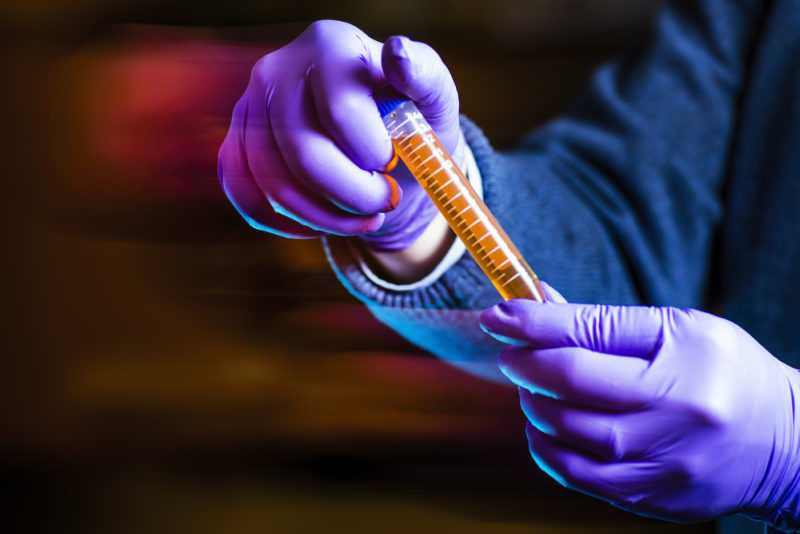In 2012, a Nature Medicine study led by Northeastern University biology professors Jonathan Tilly and Dori Woods turned human reproductive biology on its head. At the time, at Harvard Medical School, the duo found a population of stem cells in human ovaries. Marking the start of a potential egg-producing chronology, these stem cells had the potential to transform into new oocyte cells, which are the precursors to human egg cells. The discovery shattered the idea that ovaries come born with a fixed number of oocytes and, therefore, a fixed number of eggs they could possibly produce.
“It was really shocking,” Woods says, “to think that everything that we were told from when we first start learning about the ovary —a woman is born with a fixed number of oocytes, and they continually die off — might not be the case.”
Now, a March 2022 study from the two professors’ labs, spearheaded by biology PhD students Hannah Alberico and Zoe Fleischmann, further affirmed the existence of the stem cells in humans and found the first evidence of the cells actively transforming into new egg-precursor oocytes.
The combination of these discoveries represents the beginning of a new scientific framework around reproductive biology that could someday spawn a paradigm shift in clinical treatment for infertility and hormone imbalance, including during menopause.
“It’s really exciting for women’s health in general,” Woods says. “It gives us a little bit more hope for extending the longevity of the ovary.”
The new study is a product of an international collaboration with researchers in Japan at the Saitama Medical University and the United Kingdom at the University of Edinburgh, who are longstanding partners of the Northeastern labs in working to move ovary science forward. With support from Tilly and Woods, the graduate researchers worked with undergraduate Tyler Bobbitt in the professors’ shared lab space.
“It’s very collaborative, but it’s also exactly what I’m used to because we work in a joint space,” Alberico says. “I always have advising from both of them, so it was really great.”
Tilly first discovered the potential for new oocyte production in mice in 2004. Throughout the following decade, studies from all over the world found similar characteristics in many species of mammals. After the 2012 study identifying the cells in humans, over 80 papers were published to support the findings, but a few others dissented, claiming the cells did not exist.
The 2022 paper from the Northeastern team first uses a case study to investigate how and why some dissenting papers deviate from most findings. The team demonstrated how missteps in experiment and analysis could conclude that no stem cells were present. Then, using public experimental data in which no stem cells were reportedly found, they applied corrected methods to identify multiple of these stem cells.
To find the rare stem cells, scientists start with a piece of ovary tissue. Using different methods to identify the expression of genes, researchers act as detectives. They work to identify unique combinations of genes that correspond with only one possible cell type: a gene fingerprint. The name of the game is choosing the right identifying genes and then separating the cells based on type into manageable groups. In one of these methods, outdated software and a reliance on a small number of genes to identify cells caused reproductive cells to get excluded from the reproductive group.
“We used a newer version of the original software,” Alberico says. “And basically, we just took the same exact dataset, and we got out more cells.”
The team similarly showed how another sorting method, which reflects and scatters light off of cells to identify them, could accidentally pick up light from cells with a natural autofluorescent glow. In this case, the glow caused cells responsible for muscle and blood functions to be grouped as reproductive cells, further explaining the reported lack of reproductive stem cells in the reproductive group.
Using these gene-fingerprint types of cell analysis, they also found a combination of genes unique to the rare functional cell stage responsible for the transition from a stem cell to an oocyte, connecting the dots of the new egg-production chronology. The discovery of this combination of transition-stage genes closely parallels observed functions in other mammals, such as mice, that have allowed the stem cells to not only transform into eggs but also become healthy offspring.
While this discovery marks a promising indirect measurement through genes, a study isolating stem cells and directly observing if they can convert into eggs would provide more definitive direct proof of the functionality of this oocyte-producing process.
“One of the questions that we have addressed in mice that really does need to be addressed in humans is whether or not this process here is actually functional,” Woods says. “From start to finish, is this functional in an adult human ovary?”
While Tilly and Woods look to the future of human ovarian research, Fleishmann — who graduated in the summer of 2020, bolstering experience at Northeastern’s pioneering gene analysis labs — has already found an industry role, studying cancer cells and genes. Upon finishing her PhD., Alberico hopes to make an impact in an industry role with a fertility-based company.

